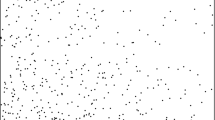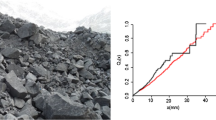Abstract
The most common standard estimator of the pair correlation function (PCF) of a point process has a pole at zero, which is in most cases a statistical artifact. However, sometimes it makes sense to assume that a pole really exists. We propose two independent approaches for the proof of existence of a PCF’s pole and for the determination of its order. In the first, we use a summary characteristic F that transforms the PCF’s pole order to the location of F’s pole, while the other one uses a natural estimation method based on Ripley’s K-function. These methods are applied to simulated samples of two classical point process models and two cluster point process models with special geometries. Finally, we use the approach in the statistical analysis of a classical point pattern of pine trees and a highly clustered pattern of nonmetallic inclusions in steel.




Similar content being viewed by others
References
Baddeley, A., Rubak, E., Turner, R. (2015). Spatial point patterns: Methodology and applications with R. Boca Raton: Chapman and Hall/CRC.
Brechet, Y. J. M. (1994). Clusters, plasticity and damage: A missing link? Materials Science and Engineering: A, 175(1–2), 63–69.
Buryachenko, V. (2007). Micromechanics of heterogeneous materials. New York: Springer.
Chiu, S. N., Liu, K. I. (2013). Stationarity tests for spatial point processes using discrepancies. Biometrics, 69(2), 497–507.
Chiu, S. N., Stoyan, D., Kendall, W. S., Mecke, J. (2013). Stochastic geometry and its applications 3rd ed. Chichester: Wiley.
Cressie, N. A. C. (1991). Statistics for spatial data. New York: Wiley.
Daley, D. J., Vere-Jones, D. (2008). An introduction to the theory of point processes: Volume II: General theory and structure. New York: Springer.
Davis, M., Peebles, P. J. E. (1983). A survey of galaxy redshifts. V-The two-point position and velocity correlations. The Astrophysical Journal, 267, 465–482.
Gelfand, A. E., Diggle, P., Fuentes, M., Guttorp, P. (2010). Handbook of spatial statistics. Boca Raton: Chapman & Hall/CRC.
Ghorbani, M. (2013). Cauchy cluster process. Metrika, 76(5), 697–706.
Guan, Y. (2007). A least-squares cross-validation bandwidth selection approach in pair correlation function estimations. Statistics & Probability Letters, 77(18), 1722–1729.
Guan, Y. (2008). A kpss test for stationarity for spatial point processes. Biometrics, 64(3), 800–806.
Illian, J., Penttinen, A., Stoyan, H., Stoyan, D. (2008). Statistical analysis and modelling of spatial point patterns, Vol. 70. Chichester: Wiley.
Martinez, V. J., Saar, E. (2002). Statistics of the galaxy distribution. Boca Raton: Chapman & Hall/CRC.
Mecke, K. R., Stoyan, D. (2005). Morphological characterization of point patterns. Biometrical Journal, 47(4), 473–488.
Peebles, P. J. E. (1974). The nature of the distribution of galaxies. Astronomy & Astrophysics, 32, 197–202.
Rathbun, S. L. (1990). Estimation and statistical inference for space-time point processes. Ph.D. thesis, Iowa State University, Ames.
Seleznev, M., Wong, K. Y., Stoyan, D., Weidner, A., Biermann, H. (2018). Cluster detection of non-metallic inclusions in 42CrMo4 steel. Steel Research International, 89(11), 1800216.
Stoyan, D. (1983). Inequalities and bounds for variances of point processes and fibre processes. Series Statistics, 14(3), 409–419.
Stoyan, D. (1994). Caution with fractal point patterns!. Statistics, 25(3), 267–270.
Stoyan, D., Stoyan, H. (1996). Estimating pair correlation functions of planar cluster processes. Biometrical Journal, 38(3), 259–271.
Tanaka, U., Ogata, Y., Stoyan, D. (2008). Parameter estimation and model selection for Neyman–Scott point processes. Biometrical Journal, 50(1), 43–57.
Totsuji, H., Kihara, T. (1969). The correlation function for the distribution of galaxies. Publications of the Astronomical Society of Japan, 21, 221–229.
Acknowledgements
Financial support of this work by the German Research Foundation (DFG) within the Collaborative Research Center 920, subproject C04, is gratefully acknowledged.
Author information
Authors and Affiliations
Corresponding author
Additional information
Publisher's Note
Springer Nature remains neutral with regard to jurisdictional claims in published maps and institutional affiliations.
About this article
Cite this article
Wong, K.Y., Stoyan, D. Poles of pair correlation functions: When they are real?. Ann Inst Stat Math 73, 425–440 (2021). https://doi.org/10.1007/s10463-020-00754-3
Received:
Revised:
Published:
Issue Date:
DOI: https://doi.org/10.1007/s10463-020-00754-3




